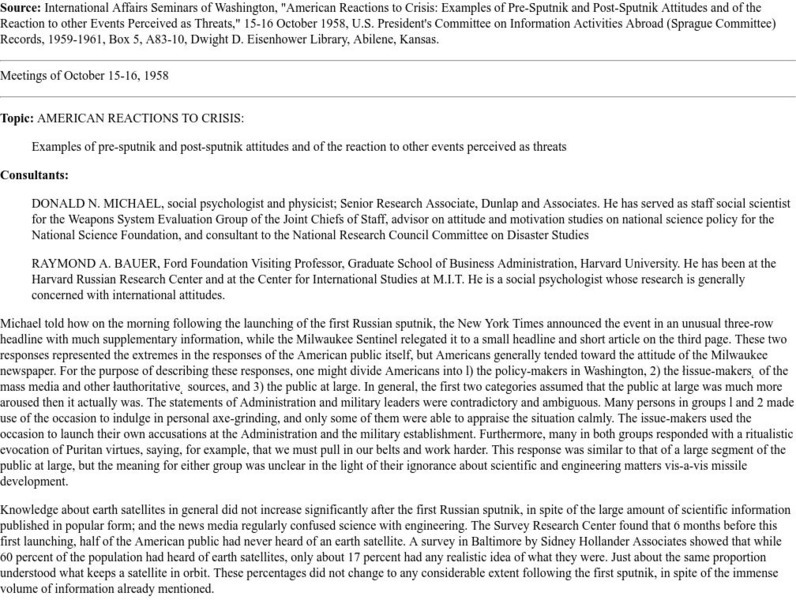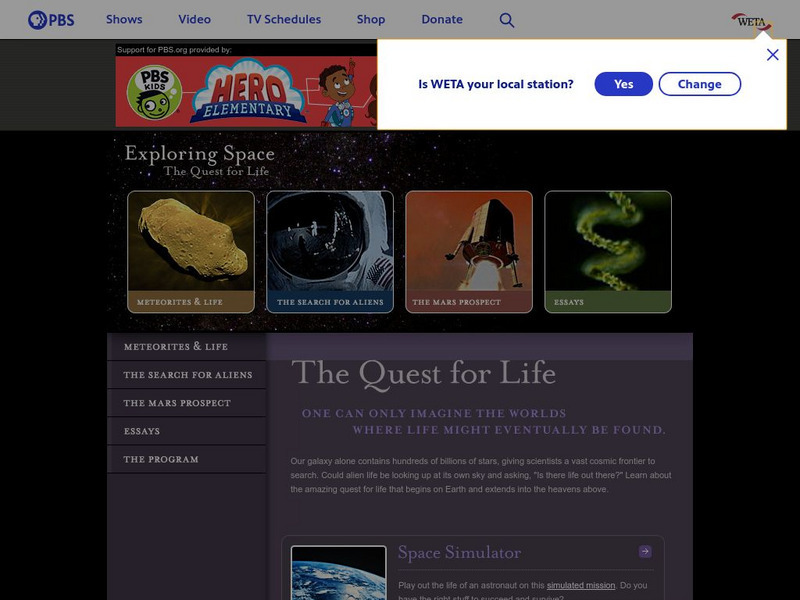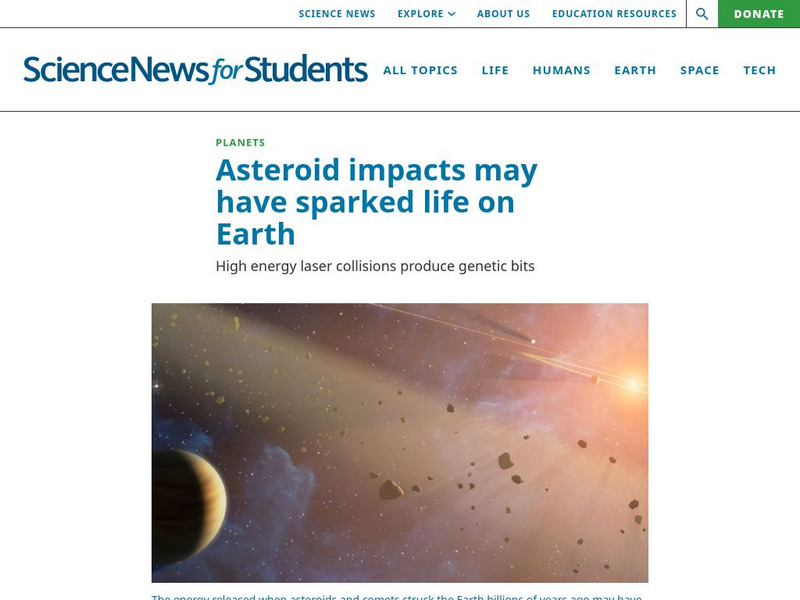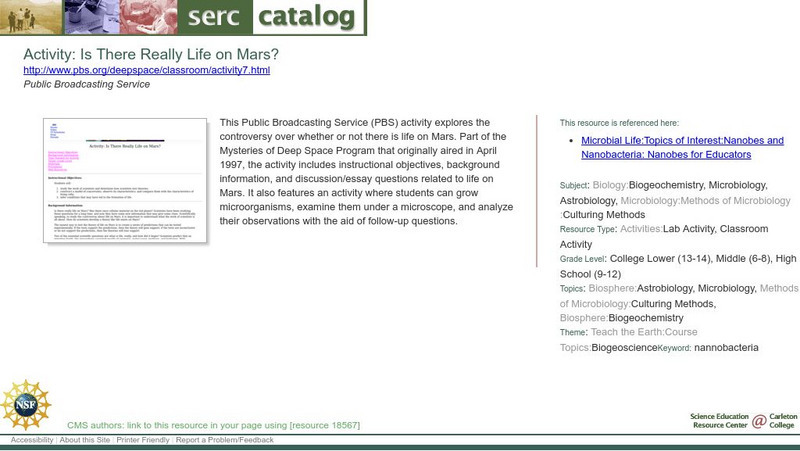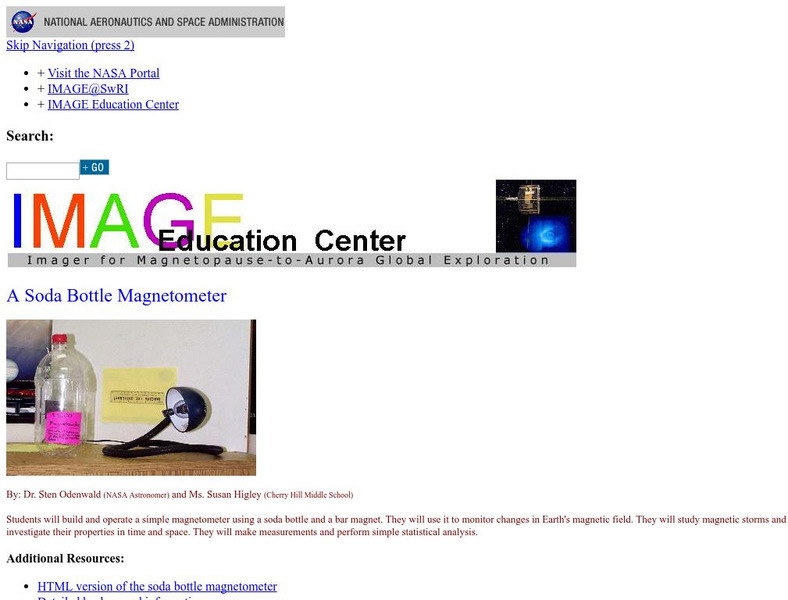Hi, what do you want to do?
Digital Public Library of America
Dpla: This Land Is Your Land: Parks and Public Spaces
This exhibition tells the story of the conservation, culture, history, and preservation of parks and protected areas through maps, documents, letters, and other primary sources.
PBS
Pbs: Nova: Anatomy of a Space Rover
Take a closer look at the space robots Spirit and Opportunity, and their scientific instruments used for exploring the surface of Mars.
Other
Lunar and Planetary Institute: Oceans From Space
This collection of photographs from space-shuttle missions shows some features of oceanic circulation that simply cannot be seen from any other vantage point. This site is a great resource for many different topics of study.
NASA
Nasa: Pre and Post Sputnik Public Attitudes
This site from NASA provides a paper that describes the public's attitiude before and after the launch of the Sputnik satellite. Originally presented as part of the "U.S. President's Committee on Information Activities Abroad."
PBS
Pbs: Exploring Space: The Quest for Life
Alien life is often theorized in many ways throughout popular culture. This site by the Public Broadcasting System attempts to shed light on the studies and exploration that are currently underway to uncover such life. This well rounded...
Khan Academy
Khan Academy: The Start of the Space Race
Looks at the USSR's launch of Sputnik and the galvanizing effect it had on America's motivation to fund aerospace research. NASA was soon formed and more funding was put in place for public education in the sciences and math.
Space Telescope Science Institute
Space Telescope Science Institute
The homepage for the Space Telescope Science Institute provides a variety of resources on the James Webb Space Telescope and Hubble Telescope. Also provided is information on the institute itself, a data archive, and a wide range of...
Society for Science and the Public
Science News for Students: Asteroid Impacts May Have Sparked Life
Article reports on a new study that claims that the energy released from asteroid collisions may have sparked life on Earth. Includes a list of key vocabulary.
TED Talks
Ted: Ted Ed: A Giant Bubble for Debate
How do you make a great public space inside a not-so-great building? Liz Diller shares the story of creating a welcoming, lighthearted addition to the Hirshhorn Museum in Washington, DC. [12:06]
CPALMS
Cpalms: Exploring the Future of Nasa
[Free Registration/Login Required] In this lesson, 8th graders analyze two nonfiction articles and a short video that look at NASA, changes to the space shuttle program, and future possibilities in the United States space program. They...
US Department of State
U.s. Department of State: Decades of Change: 1960 1980
Summary of the rise of cultural and ethnic pluralism that took place in America between 1960 -1980 causing major social change. Included were such movements as civil rights, women, Latino, Native-American, counterculture,...
Other
Quill and Quire: Author Profile: Timothy Findley's Public Face and Price Space
An interesting look at the personal life and writing projects of Canadian author, Timothy Findley. Includes an area where you can search for reviews of Findley's books.
NPR: National Public Radio
Npr: America's First Spaceman
Use this site to learn all about the first man to reach the edge of space, paving the way for the space exploration program. Related links available.
Digital Public Library of America
Dpla: Women in Science: Space Exploration
Through primary source documents, discover the history of NASA's "human computers," early aerospace industry pioneers, and the struggle for American women to be allowed into the astronaut program.
Science Education Resource Center at Carleton College
Serc: Activity: Is There Really Life on Mars?
This Public Broadcasting Service (PBS) activity explores the controversy over whether or not there is life on Mars. Part of the Mysteries of Deep Space Program that originally aired in April 1997, the activity includes instructional...
NASA
Nasa: Educator Features and Articles
K-12 educational articles, lesson plans, and other teaching materials on current NASA projects that meet national education standards. NASA generates awareness of students' interest in space, science, mathematics, geography, and...
NASA
Nasa: Educator Features and Articles
K-12 educational articles, lesson plans, and other teaching materials on current NASA projects that meet national education standards. NASA generates awareness of students' interest in space, science, mathematics, geography, and...
Society for Science and the Public
Science News for Students: So Many 'Earths'
Article reports on the recent discovery that many suns in the universe host "Earth-like" planets. Includes a vocabularly list.
Other
Kid Space: Magazing & Newspaper Articles
Here are descriptions of popular magazines appropriate for young readers from the Public Library of Cincinnati and Hamilton County. Follow linked titles to the magazines' homepages.
Digital History
Digital History: Conquering Space
A good review of how the rise of nationalism led to western expansion, support for federal funds to build infrastructure, and the protection of new American industry.
Digital Public Library of America
Dpla: Race to the Moon
In 1955, the US and the USSR each announced plans to launch a satellite into orbit. Thus began the race to the moon. Throughout the 1960s and 1970s, the American space program and its new classes of astronauts achieved breakthroughs in...
Other
Evergreen
A national charity created to turn schools into green space that celebrate the environment, as well as preserve natural outdoor spaces within Canadian cities, Evergreen has core programs: Learning Grounds - transforming school grounds,...
NASA
Nasa: Image Science Center: Soda Bottle Magnetometer
Help students explore Earth's magnetic field with this soda bottle magnetometer activity. Follow links to other space projects for the classroom.
A&E Television
History.com: The Soviet Response to the Moon Landing? Denial There Was a Moon Race at All
Until 1989, Russians claimed they were not trying to reach the Moon first and that the U.S. was in "a one-nation race." Until 1989, a group of American aerospace engineers went to Moscow and finally saw the Soviets' failed lunar-landing...







